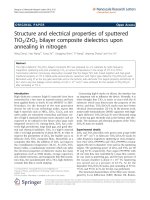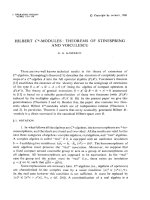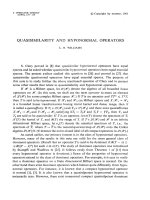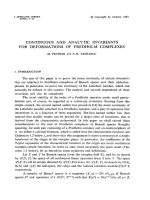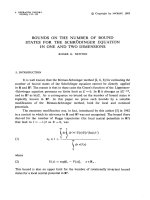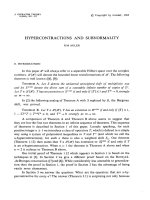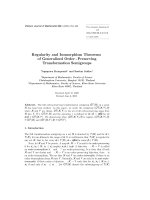Báo cáo toán học: "Partitions and Edge Colourings of Multigraphs" pps
Bạn đang xem bản rút gọn của tài liệu. Xem và tải ngay bản đầy đủ của tài liệu tại đây (89.89 KB, 4 trang )
Partitions and Edge Colourings of Multigraphs
Alexandr V. Kostochka
∗
and Michael Stiebitz
†
Submitted: May 23, 2007; Accepted: Jul 1, 2008; Published: Jul 6, 2008
Abstract
Erd˝os and Lov´asz conjectured in 1968 that for every graph G with χ(G) > ω(G)
and any two integers s, t ≥ 2 with s +t = χ(G) +1, there is a partition (S, T ) of the
vertex set V (G) such that χ(G[S]) ≥ s and χ(G[T ]) ≥ t. Except for a few cases,
this conjecture is still unsolved. In this note we prove the conjecture for line graphs
of multigraphs.
1 Introduction
It was conjectured by Erd˝os and Lov´asz (see Problem 5.12 in [2]) that for every graph G
with χ(G) > ω(G) and any two integers s, t ≥ 2 with s +t = χ(G) +1, there is a partition
(S, T ) of the vertex set V (G) such that χ(G[S]) ≥ s and χ(G[T ]) ≥ t. The only settled
cases of this conjecture that we know are (s, t) ∈ {(2, 2), (2, 3), (2, 4), (3, 3), (3, 4), (3, 5)}
(see [1, 3, 5, 6]). In this note we prove for the line graphs of multigraphs the following
slightly stronger statement.
Theorem 1 Let s and t be arbitrary integers with 2 ≤ s ≤ t. If the line graph L(G) of
some multigraph G has chromatic number s + t − 1 > ω(L(G)), then it contains a clique
Q of size s such that χ(L(G) − Q) ≥ t.
It will be convenient to prove the theorem in the language of edge colorings of multi-
graphs. Every multigraph in this note is finite, undirected and has no loops.
The edge set and the vertex set of G is denoted by V (G) and E(G) respectively. For
a vertex v of G, the degree, d(v), of v in G is the number of edges incident with v. The
set N
v
of all neighbours of v in G may have much smaller size than d(v).
∗
Department of Mathematics, University of Illinois, Urbana, IL 61801 and Institute of Mathematics,
Novosibirsk 630090, Russia. E-mail address: This material is based upon
work supported by NSF Grants DMS-0400498 and DMS-06-50784 and grant 06-01-00694 of the Russian
Foundation for Basic Research.
†
Institute of Mathematics, Technische Universit¨at Ilmenau, D-98684 Ilmenau, Germany. E-mail ad-
dress:
the electronic journal of combinatorics 15 (2008), #N25 1
The chromatic index of G, denoted by χ
(G), is the chromatic number of its line graph
L(G); in other words, it is the smallest number of colours with which the edges of G may
be coloured so that no two adjacent edges receive the same colour.
A triangle in G is a set of three mutually adjacent vertices in G, and the edges of
a triangle are those edges in E(G) joining the vertices of the triangle. The maximum
number of edges in a triangle in G will be denoted by τ(G). Furthermore, let ∆(G)
denote the maximum degree of G, and let ω
(G) = max{τ (G), ∆(G)}. Clearly, ω
(G) is
the clique number of the line graph of G and hence χ
(G) ≥ ω
(G).
2 Proof of Theorem 1
For given 2 ≤ s ≤ t, suppose that G is a counterexample with the fewest vertices. Then
G is connected. Since χ
(G) > ω
(G) ≥ τ(G), G contains at least four vertices. By
Shannon’s theorem [4], χ
(G) ≤
3
2
∆(G). Consequently, s ≤ ∆(G).
By an s-star of G we mean a pair (E
, v) such that E
⊆ E(G) is a set of s edges
incident with the vertex v. For an s-star (E
, v), let X(E
, v) denote the set of all vertices
of G joined by an edge of E
with v.
Let (E
, v) be an arbitrary s-star of G. The set E
forms an s-clique in L(G). Since G
is a counterexample to our theorem, we have χ
(G − E
) ≤ t − 1. Let G
= G − E
, and
let ϕ : E(G
) −→ {1, . . . , t − 1} be a (t − 1)-edge-colouring of G
. For each vertex x of G,
let
ϕ(x) = {ϕ(e)| e ∈ E(G
) is incident with x} and ¯ϕ(x) = {1, . . . , t − 1} \ ϕ(x).
Since s + t − 1 = χ
(G) > ω
(G) ≥ ∆(G) and all s edges of E
are incident with v, the
degree of v in G
= G − E
is at most t − 2 and, therefore,
(a) ¯ϕ(v) = ∅.
Next, we claim that
(b) for every colour α ∈ ¯ϕ(v) and for any two distinct vertices x, y ∈ X(E
, v), there is
an edge e ∈ E(G
) joining x and y with ϕ(e) = α. Consequently, |X(E
, v)| ≤ 2.
Proof. Suppose to the contrary that no edge joining x and y is colored with α. For
u ∈ {x, y}, there is an edge e
u
∈ E
joining u and v. Colour the s − 1 edges of E
\ {e
x
}
with colours t, t + 1, . . . , t + s −2, so that e
y
is coloured with t. If α ∈ ¯ϕ(x), we can colour
the edge e
x
with α. Otherwise, there is an edge e ∈ E(G) \ E
incident with x colored
with α. Since e is not incident with y, we can recolour e with colour t and then colour
e
x
with α. In both cases we obtain a (t + s − 2)-edge-colouring of G, a contradiction to
s + t − 1 = χ
(G).
(c) Let w be a vertex of G with d(w) ≥ s. Then, for the neighbourhood N
w
of w in G,
we have |N
w
| ≥ 2, and any two vertices of N
w
are adjacent in G. Furthermore, if
s ≥ 3, then |N
w
| = 2.
the electronic journal of combinatorics 15 (2008), #N25 2
Proof. If N
w
consists only of a single vertex w
, then d(w
) ≥ d(w) ≥ s. Since G is
connected and has at least four vertices, w
has a neighbour x = w. Hence there is an
s-star (E
, w
) of G with w, x ∈ X(E
, w
). From (a) and (b) it then follows that x and w
are adjacent in G, a contradiction to |N
w
| = 1. This proves that |N
w
| ≥ 2. If x, y are two
distinct neighbours of w, then there is an s-star (E
, w) with x, y ∈ X(E
, w). Then (a)
and (b) imply that x and y are adjacent. If s ≥ 3 and |N
w
| ≥ 3, then there is an s-star
(E
, w) such that |X(E
, w)| ≥ 3, a contradiction to (b). Hence (c) is proved.
To complete the proof of Theorem 1, we consider two cases.
Case 1: s ≥ 3. Since s ≤ ∆(G), there is a vertex u in G with d(u) ≥ s. By (c), N
u
consists of two vertices, say x and y, and these two vertices are adjacent in G. Since G
is a connected graph with at least four vertices, either N
x
or N
y
contains more than two
vertices, say |N
x
| ≥ 3. Then (c) implies that d(x) < s. Let E
1
denote the set of all edges of
G joining x with u or y. Furthermore, let E
2
denote the set of all edges of G joining u with
y. Then 2 ≤ |E
1
| < s and |E
1
|+|E
2
| ≥ s. Hence, there is a nonempty subset E
2
of E
2
such
that E
= E
1
∪ E
2
contains exactly s edges. Since E
is an s-clique in L(G), by the choice
of G, we have χ
(G − E
) ≤ t − 1. Let G
= G − E
, and let ϕ : E(G
) −→ {1, . . . , t − 1}
be any (t − 1)-edge-colouring of G
. If ϕ(u) = {1, . . . , t − 1}, then {u, x, y} is a triangle
with at least s + t − 1 edges, a contradiction to τ (G) < χ
(G) = s + t − 1. Hence there
is a colour α ∈ ¯ϕ(u). Choose two edges e
1
∈ E
1
and e
2
∈ E
2
. Colour the s − 1 edges of
E
\ {e
1
} with colours t, t + 1, . . . , t + s − 2 so that e
2
is coloured with t. If α ∈ ¯ϕ(x), then
we can colour the edge e
1
with α. Otherwise, there is an edge e ∈ E(G) \ E
such that
e is incident with x and ϕ(e) = α. Since all edges joining x with y are in E
, the edge e
is not incident with y and we can recolour e with t and then colour e
1
with α. In both
cases we obtain a (t + s − 2)-edge colouring of G, a contradiction to s + t − 1 = χ
(G).
Case 2: s = 2. Since s ≤ ∆(G), it follows from (c) that G contains a triangle T =
{x, y, z}.
For u ∈ {y, z}, there is an edge e
u
in G joining u and x. The pair (E
, x) with
E
= {e
y
, e
z
} is an s-star of G and, therefore, χ
(G − E
) ≤ t − 1. Let G
= G − E
, and
let ϕ : E(G
) −→ {1, . . . , t − 1} be any (t − 1)-edge-colouring of G
.
Since T contains at most τ(G) ≤ χ
(G) − 1 = t edges and two of these edges are not
coloured, some colour α ∈ {1, . . . , t − 1} is not present on edges of T . By (b), α ∈ ϕ(x).
Hence the following two subcases finish the proof of the theorem.
Case 2.1: α ∈ ¯ϕ(y) ∪ ¯ϕ(z). By the symmetry between y and z, we can suppose that
α ∈ ¯ϕ(y). By (a) and (b), there is a colour β ∈ ¯ϕ(x) and an edge e
of colour β joining
y and z. Uncolour e
and colour e
z
with β. This results in a (t − 1)-edge-colouring ϕ
of
G − E
, where E
= {e
y
, e
}. Then α ∈ ¯ϕ
(y) and no edge joining x and z has colour α.
Since (E
, y) is an s-star of G, this is a contradiction to (b).
Case 2.2: α ∈ ϕ(x) ∩ ϕ(y) ∩ ϕ(z). This means that for every u ∈ T , there is an
edge e
u
∈ E(G
) of colour α joining u and some vertex v
u
∈ T . Let β ∈ ¯ϕ(x) and
P be the component containing x of the subgraph H
α,β
induced by the set of edges
{e ∈ E(G
) | ϕ(e) ∈ {α, β} }. Obviously, P is a path starting at x. By (b), there is an
edge e
of colour β joining y and z and we eventually consider two cases.
the electronic journal of combinatorics 15 (2008), #N25 3
Subcase A: Edge e
does not belong to P . If we interchange the colours α and β on P ,
then we obtain a new (t − 1)-edge-colouring ϕ
of G
. Then ϕ
is a (t − 1)-edge-colouring
of G
with α ∈ ¯ϕ
(x) and ϕ
(e
y
) = ϕ
(e
z
) = α. In particular, no edge of G
= G − E
joining y and z has colour α, a contradiction to (b).
Subcase B: Edge e
belongs to P . In this case, e
y
and e
z
also belong to P . By
symmetry, we may assume that the subpath P
of P joining y with x does not contain
z. Uncolour e
and colour e
y
∈ E
with β. This results in a (t − 1)-edge-colouring ϕ
of
G − {e
z
, e
} for which Subcase A with z in place of x and e
y
in place of e
holds. Since
Subcase A is settled, this finishes the whole proof.
References
[1] W. G. Brown and H. A. Jung, On odd circuits in chromatic graphs, Acta Math. Acad. Sci.
Hungar. 20 (1999), 129–134.
[2] T. R. Jensen and B. Toft, Graph Coloring Problems, Wiley Interscience, New York, 1995.
[3] N. N. Mozhan, On doubly critical graphs with chromatic number five, Technical Report 14,
Omsk Institute of Technology, 1986 (in Russian).
[4] C. E. Shannon, A theorem on coloring the lines of a network, J Math. Phys. 28 (1949),
148–151.
[5] M. Stiebitz, K
5
is the only double-critical 5-chromatic graph, Discrete Math. 64 (1987),
91–93.
[6] M. Stiebitz, On k-critical n-chromatic graphs. In: Colloquia Mathematica Soc. J´anos Bolyai
52, Combinatorics, Eger (Hungary), 1987, 509–514.
the electronic journal of combinatorics 15 (2008), #N25 4

